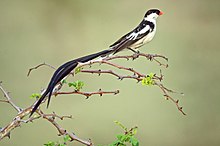Dominican widow
| Dominican widow | ||||||||||||
|---|---|---|---|---|---|---|---|---|---|---|---|---|

Dominican widow ( Vidua macroura ) |
||||||||||||
| Systematics | ||||||||||||
|
||||||||||||
| Scientific name | ||||||||||||
| Vidua macroura | ||||||||||||
| ( Pallas , 1764) |
The Dominican widow ( Vidua macroura ) is a species of bird from the family of widow birds (Viduidae) native to Africa , in which the male has four greatly elongated control feathers during the breeding season.
As is typical for widow birds, the Dominican widow is an obligatory brood parasite that allows its offspring to be raised by host birds.
The population of the Dominican widow was classified in the IUCN Red List of Threatened Species in 2016 as “ Least Concern (LC) ” = “not endangered”.
features
Dominican widows have a body length of 12.5 to 13 centimeters. In the magnificent dress, the male has strongly elongated tail feathers, so that he then has a body length of up to 34 centimeters. The wing length is 6.4 to 7.5 centimeters. Females weigh an average of 14.4 grams, males an average of 15.9 grams.
The sexual dimorphism is very pronounced during the breeding season. The upper side of the body of the males is glossy black, the underside of the body is white. The legs of the male are gray-black, the beak is pink to bright red. Most noticeable are the elongated middle four control springs that taper to a point. In contrast, the female and the male in resting dress are colored similar to a sparrow . The male also has a pink or bright red beak outside of the breeding season. In females, the upper beak is blackish during the breeding season, but reddish brown outside the breeding season. Young birds resemble the female, but their plumage is grayer and not as clear maroon and isabel-colored as the female or the male in simple dress.
It can be confused with the king widow , a widow bird that is also widespread in sub-Saharan Africa . The males of both species show a similar distribution of black body plumage in the breeding dress. The simplest distinguishing feature is that the extended control feathers of the Dominican widow taper to a point. The extended control feathers of the king widow, on the other hand, are spatulate-shaped at the end. The underside of the king's widow's body is also yellow.
Distribution area and habitat
The distribution area of the Dominican widow extends from Senegal and Sudan to South Africa. It is thus in most of Africa the south Sahara widespread.
The Dominican widow is found in a number of very different habitats, including savannahs and grasslands. Basically, this species prefers open, grass-dominated areas with individual trees and bushes. Areas that are close to water are particularly preferred. The Dominican widow can also be found in clearings and along tropical rivers. It is also found on agricultural land and in gardens.
The altitude distribution ranges from the lowlands at sea level to altitudes of 2250 meters. However, above 1800 meters it is not a common bird.
Way of life
The Dominican widow is one of those birds that always have their offspring raised by alien birds, and is therefore one of the obligatory parasites. Like all widow birds, the Dominican widow only parasitizes species from the finch family . They only lay one egg at a time in the nest of their host birds. Unlike the cuckoo found in Central Europe and numerous other brood parasitic cuckoos, nestlings of the Dominican widow neither throw eggs from their host parents nor their nestlings out of the nest. There is also no competition for displacement with the nestlings of the host birds. Rather, the nestling grows up together with the nestlings of the host bird parents. So far it has not yet been conclusively investigated how long the eggs of the Dominican widow have to be incubated before the nestlings hatch. The breeding period for the host birds is 11 to 12 days.
The most important host bird is the coral reef , which can reach a body length of up to 13 centimeters. The young birds of the Dominican widow also have the same throat pattern as the wavelike deer.
The golden breast , which reaches a body length of up to ten centimeters and is also widespread south of the Sahara, is another important host bird, at least in some regions of the Dominican widow's distribution area. Orange cheek , gray anambra , anambra and marsh only have regional significance as host birds.
Dominican widow as an ornamental bird
Because of the magnificent courtship dress, Dominican widows are occasionally kept as ornamental birds. In order to breed them successfully, an aviary with several pairs of host birds is necessary.
literature
- Horst Bielfeld : Knowing and caring for 300 ornamental birds. Ulmer Verlag, Stuttgart 2009, ISBN 978-3-8001-5737-2 .
- Paul A. Johnsgard: The Avian Brood Parasites - Deception at the Nest . Oxford University Press, Oxford 1997, ISBN 0-19-511042-0 .
Web links
- Vidua macroura in the endangered Red List species the IUCN 2008. Posted by: BirdLife International, 2008. Accessed September 7 2016th
- Videos, photos and sound recordings for Vidua macroura in the Internet Bird Collection
- Dominican widow on Xeno-Canto
Single receipts
- ↑ Vidua macroura in the endangered Red List species the IUCN 2016 Posted by: BirdLife International, 2016. Accessed January 29, 2018th
- ↑ Johnsgard: The Avian Brood Parasites . P. 308.
- ↑ a b c Johnsgard: The Avian Brood Parasites . P. 309.
- ↑ Johnsgard: The Avian Brood Parasites . P. 306.
- ↑ Johnsgard: The Avian Brood Parasites . P. 310.



